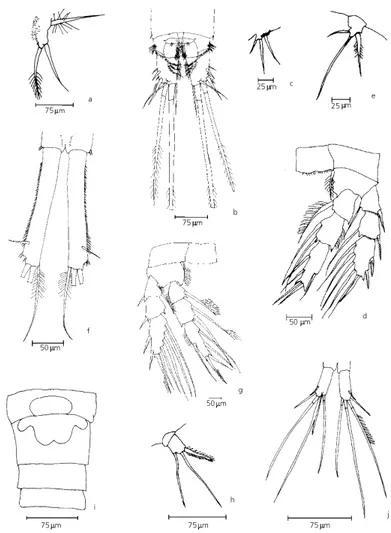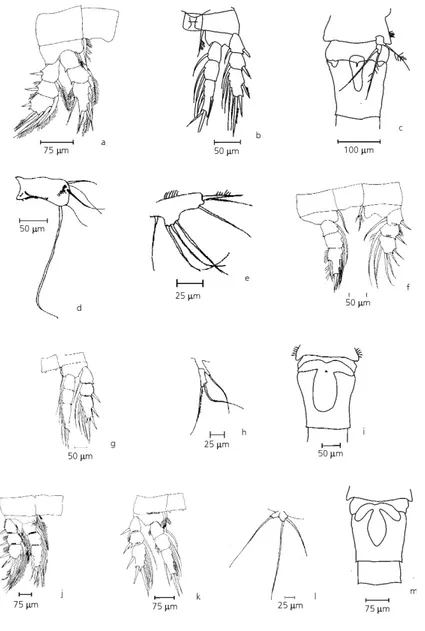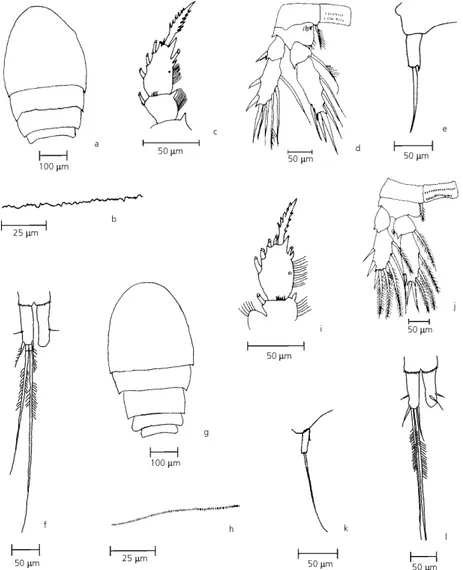CYCLOPIDAE (CRUSTACEA, COPEPODA) FROM THE
UPPER PARANÁ RIVER FLOODPLAIN, BRAZIL
LANSAC-TÔHA, F. A., VELHO, L. F. M., HIGUTI, J.and TAKAHASHI, E. M.
Universidade Estadual de Maringá, Nupélia, Department of Biology, Postgraduate Course in Ecology of Continental Aquatic Environments,
Av. Colombo, 5790, CEP 87020-900, Maringá, PR, Brazil
Correspondence to: Fábio Amodêo Lansac-Tôha, Universidade Estadual de Maringá, Nupélia, Department of Biology, Postgraduate Course in Ecology of Continental Aquatic Environments, Av. Colombo, 5790, CEP 87020-900, Maringá, PR, Brazil, e-mail: fabio@nupelia.uem.br Received March 24, 2000 – Accepted November 29, 2000 – Distributed February 28, 2002
(With 6 figures)
ABSTRACT
Cyclopid copepods from samples of fauna associated with aquatic macrophytes and plancton obtained in lotic and lentic environments were obtained from the upper Paraná River floodplain (in the states of Paraná and Mato Grosso do Sul, Brazil). Macrophytes were collected in homogeneous stands and washed. Plankton samples, taken from the water column surface and bottom, were obtained using a motor pump, with a 70 µm mesh plankton net for filtration. Twelve taxa of Cyclopidae were identified. Among them, Macrocyclops albidus albidus, Paracyclops chiltoni, Ectocyclops rubescens, Homocyclops ater, Eucyclops solitarius, Mesocyclops longisetus curvatus, Mesocyclops ogunnus, and Microcyclops finitimus
were new finds for this floodplain. Eight species were recorded exclusively in aquatic macrophyte samples. Among these species, M. albidus albidus and M. finitimus presented greatest abundances. Only four
species were recorded in plankton samples, and Thermocyclops minutus and Thermocyclops decipiens
are limited to this type of habitat. Among these four species, T. minutus is the most abundant,
espe-cially in lentic habitats.
Key words: Cyclopidae, taxonomy, phytophyle fauna, zooplankton, Paraná River.
RESUMO
Cyclopidae (Crustacea, Copepoda) da planície de inundação do alto rio Paraná, Brasil
Foram obtidos copépodes cyclopídeos de amostras de fauna associadas a macrófitas aquáticas e plâncton de ambientes lóticos e lênticos da planície de inundação do alto rio Paraná (nos Estados do Paraná e Mato Grosso do Sul). As amostras foram coletadas em bancos homogêneos e lavadas. As amostras de plâncton, tomadas à superfície e fundo da coluna de água, foram obtidas com o auxílio de uma motobomba, utilizando-se uma rede de plâncton de abertura de malha de 70 µm para filtração. Doze táxons de Cyclopidae foram identificados. Entre eles, Macrocyclops albidus albidus, Paracyclops chiltoni, Ectocyclops rubescens, Homocyclops ater, Eucyclops solitarius, Mesocyclops longisetus curvatus, Mesocyclops ogunnus e Microcyclops finitimus representam novos registros para essa planície.
Oito espécies foram registradas exclusivamente em amostras de macrófitas aquáticas. Entre essas,
M. albidus albidus e M. finitimus são as mais abundantes. Somente quatro espécies foram registradas
em amostras de plâncton, e Thermocyclops minutus e Thermocyclops decipiens são exclusivas para
esse tipo de habitat. Dessas quatro espécies, T. minutus é a mais abundante, especialmente em ambientes
lênticos.
INTRODUCTION
In Brazil, studies of cyclopid copepods have traditionally been dealt with prior to their bio-logical and ecobio-logical aspects. Among the studies developed about taxonomic aspects, those un-dertaken by Reid (1985) include the development of identification keys and list of references for South American freshwater species. Recently, Rocha & Botelho (1998) reviewed cyclopoid species recorded in Brazil, providing information on taxonomy and geographical distribution of the species.
Research was carried out in the floodplain of the upper Paraná River, and species composition of cyclopid copepods from samples of both fauna associated with aquatic macrophyte and plankton are described.
MATERIAL AND METHODS
Cyclopid copepods from Eichhornia azurea
Kunth associated fauna and plankton samples were
obtained from lotic and lentic environments from the upper Paraná River floodplain, states of Paraná and Mato Grosso do Sul (22o40’-22o50’S, 53o 10’-53o40’W), Brazil (Fig. 1), from March 1992 to February 1993. Macrophytes were collected in homogeneous stands washed in pails with for-maldehyde 4% solution. Plankton samples were obtained by horizontal and vertical hauls and a pump. A plankton net, mesh size of 70 µm for filtration, was used. Samples were taken at different depths in the pelagic region and from the surface of the littoral region.
For identification of different taxa, organisms were separated, mounted on slides with glycerin, analyzed, and measured by Wild M20 microscope. Sketches of organisms were made with a drawing tube. Measurements were taken with a pre-calibrated micrometric eyepiece. In the case of Ectocyclops
rubescens (Brady), males were also used.
Material was placed in the zooplankton la-boratory of the Research Nucleus in Limnology, Ichthology, and Aquaculture of the Universida-de Estadual Universida-de Maringá, Maringá, Paraná, Brazil.
53 15’o
53 15’o
53 30’o
53 30’o
Porto Rico town
Paraná State Mato Grosso do Sul
State
23 00’o
23 00’o
22 45’o 22 45’o
Baía River River River Paraná Paraná South America Channel Curutuba Brazil 2.5 km Paraná R. Ivinhema River Floresta Island Mutum Island Guaraná Lake Boi Stream Jandira Stream BaíaRiver Patos Lake Ivinheima River Cortado Channel Paraná River Paraná State
RESULTS
Ectocyclops rubescens Brady, 1904 (Fig. 2a, b, c) Herbst, 1962: 268-269, figs. 24-31; Reid, 1985: 35, fig. 4; Morton, 1990: 670-672, fig. 7.
Commentaries: This species is common in
samples of fauna associated with aquatic macro-phytes from lentic and lotic environments of the upper Paraná River floodplain. It was not registered in plankton samples. This is the first record for the upper Paraná River floodplain.
Eucyclops solitarius Herbst, 1959 (Fig. 2d, e, f) Herbst, 1959: 49, figs. 1-4; Reid, 1985: 39, figs. 121-123; Defaye & Dussart, 1988: 118, figs. 81-87.
Commentaries: E. solitarius is rare in the upper
Paraná River floodplain. It had only been registered only in samples of fauna associated with aquatic macrophytes from lentic and lotic environments. This is the first record for this floodplain.
Homocyclops ater (Herrick, 1882) (Fig. 2g, h, i, j)
Reid, 1985: 31, figs. 59-61; Fallavena, 1985, fig. 6 (as Macrocyclops ater); Montú & Goeden, 1986:
111, fig. 34 (as Macrocyclops ater).
Commentaries: Rare species in the upper
Paraná River floodplain. It had only been registered in samples of fauna associated with aquatic macro-phytes from lentic environments. This is the first record for the upper Paraná River floodplain.
Fig. 2 — a-c) Ectocyclops rubescens (female): a) P5; b) caudal rami, male: c) P6; d-f) Eucyclops solitarius (female): d)
P4; e) P5; f) caudal rami; g-j) Homocyclops ater (female): g) P4; h) P5; i) seminal receptacle and abdominal segments; j)
Macrocyclops albidus albidus (Jurine, 1820) (Fig. 3a, b, c, d)
Dussart, 1984: fig. 13; Reid, 1985: 32, figs. 66-69; Fallavena, 1985, fig. 5 (as M. albidus); Montú
& Goeden, 1986: 116, fig. 35-i (as M. albidus);
Chengalath & Shih, 1994: 2425-2426, fig. 3.
Commentaries: Abundant species in the
flood-plain in samples of fauna associated with aquatic macrophytes; greater abundance in lotic environ-ments. It had not been recorded in plankton sam-ples. This is the first record for the upper Paraná River floodplain.
Paracyclops chiltoni (Thomson, 1882) (Fig. 3 e, f, g, h)
Smith & Fernando, 1978: 2022, figs. 40-42; Reid, 1985: 34, fig. 75; Dussart & Frutos, 1986: pl. IX, figs. 60-61; Suárez-Morales et al., 1996: 179, fig.62;
Karaytug & Boxshall, 1998: 590-598, figs. 17-23.
Commentaries: This species is common in the
upper Paraná River floodplain in samples of fauna associated with aquatic macrophytes from lentic and lotic environments. It had not been recorded in plankton samples. This is the first record of the species for this floodplain.
Mesocyclops meridianus (Kiefer, 1926) (Fig. 4a, b, c)
Dussart, 1984: 60, fig. 26; 1987: 152, figs. 27-35; Reid, 1985: 45-46, figs. 183-186; Dussart & Frutos, 1985: 313, figs. 56-59; Silva et al.,
1989: 729, figs. 155-183; Reid & Pinto Coelho, 1994: 361.
Commentaries: Frequent and abundant
species in lentic and lotic environments of the upper Paraná River floodplain in samples of fauna associated with aquatic macrophytes, with
greater abundances in lentic environments. It has been recorded in plankton samples, but in low frequence and abundance.
Mesocyclops ogunnus Onabamiro, 1957 (Fig. 4d, e, f, g, h, i)
Onabamiro, 1957: 125, figs. 7-12; Dussart & Fernando, 1988: 241, 250-251, figs. 28-30; Boxshall & Braide, 1991: 208-209, 212, fig. 64; Reid & Kay, 1992: 331, 336-339, fig. 3d-f; Reid & Pinto-Coelho, 1994: 360-361.
Fig. 4 — a-c) Mesocyclops meridianus (female): a) P1; b) P4; c) genital segment with seminal receptacle and P5; d-i) Mesocyclops ogunnus (female): d) basipodite of antenna; e) maxillular palp; f) P1; g) P4; h) P5; i) pediger 5 and genital segment with seminal
Commentaries: M. ogunnus, an Afro-Asian
species recently introduced into Brazil, in Furnas Reservoir situated in the south of Minas Gerais, partly bordering São Paulo State (Reid & Pin-to-Coelho, 1994). Rare in lentic and lotic environ-ments of the upper Paraná River floodplain, and recorded only in samples of fauna associated with aquatic macrophytes. It is the first record for this floodplain.
Mesocyclops longisetus curvatus Dussart, 1987 (Fig. 4j, k, l, m)
Dussart, 1987: 150, 156, figs. 3-4, 7-8; Reid & Reed, 1994: 80-82, figs. 1-2; Reid & Pinto-Coelho, 1994: 367;
Suárez-Morales et al., 1996: 12, figs. 33-35, 89 a-b.
Commentaries: This species is common in
the upper Paraná River floodplain, in samples of fauna associated with aquatic macrophytes. Greater abundance in lentic environments. This is the first register for this floodplain.
Microcyclops anceps anceps (Richard, 1897) (Fig. 5a, b, c, d, e, f)
Richard, 1897: 265, figs. 1-4; Sendacz & Kubo, 1982: 81, figs. 72-75 (as M. anceps); Matsumura-Tundisi
& Rocha, 1983: fig. VI (as M. anceps); Reid, 1985:
54, figs. 4-16; Rocha, 1998: 427-429, pl. I, figs. 1-2 , pl. II, fig. 13, pl. III, fig. 17.
Fig. 5 — a-f) Microcyclops anceps anceps (female): a) dorsal view of prosomal somites; b) detail of posterior border of
second prosomal somite; c) frontal view of terminal segment of P1 endopod; d) P4; e) P5; f) caudal rami and setae; g-l)
Commentaries: Frequent species in the
flood-plain with greater abundance in lentic environ-ments, especially in samples of fauna associated with aquatic macrophytes.
Microcyclops finitimus Dussart, 1984 (Fig. 5g, h, i, j, k, l,)
Dussart, 1984: 57-58, fig. 19A; Silva et al., 1989:
729, figs. 184-197; Rocha, 1998: 427-429, pl. I, fig. 7, pl. II, fig. 12, pl. III, fig. 18.
Commentaries: Abundant species in lentic and
lotic environments of the upper Paraná River floodplain
in fauna associated with aquatic macrophytes. It had not been recorded in plankton samples. This is the first register for the upper Paraná River floodplain.
Thermocyclops decipiens (Kiefer, 1929) (Fig. 6a, b, c)
Sendacz & Kubo, 1982: 75-76, figs. 44-57 (as T.
crassus); Reid, 1985: 49, figs. 224-227; Defaye
et al., 1987: 3145, figs. 11-19.
Commentaries: Frequent and abundant
spe-cies in plankton samples of the upper Paraná River floodplain.
Fig. 6— a-c) Thermocyclops decipiens (female): a) P4; b) P5; c) genital segment with seminal receptacle, abdominal segments
and caudal rami; d-g) Thermocyclops minutus (female): d) P4; e) P5; f) genital segment with seminal receptacle; g)
Greatest densities have been registered in lentic environments.
Thermocyclops minutus (Lowndes, 1934) (Fig. 6d, e, f, g)
Lowndes, 1934: 113, fig. 10 (as Mesocyclops minutus); Sendacz & Kubo, 1982: 76, figs.
51-56; Matsumura-Tundisi & Rocha, 1983, figs. I. 2; Reid, 1985: 49, figs 217-219.
Commentaries: T. minutus is the most frequent
and abundant species of copepods in plankton sam-ples of the upper Paraná River floodplain. Greatest abundance of this species is in lentic environments.
DISCUSSION
Species richness of cyclopoid copepods asso-ciated with Eichhornia azurea was greater than
that found in plankton samples collected in the same type of habitats from the upper Paraná River floodplain.
Among the most frequent and abundant spe-cies of phytophile fauna, such as Microcyclops anceps anceps, M. finitimus, Macrocyclops albidus
albidus, and Mesocyclops meridianus, only M.
anceps anceps and M. meridianus have been
recorded in low frequency and low abundance in plankton samples. Inversely, the most frequent and abundant species in the plankton, Thermocyclops minutus and T. decipiens were not found associated
with E. azurea.
Paggi (pers. comm.) suggested that there is a transversal gradient of abundance in which cy-clopids increase in richness and abundance from the pelagic region toward the littoral region.
According to McLachlan (1969), predadors seem to be favored by the great compactness of aquatic macrophyte banks. In the present study the occurrence of many predatory cyclopid species suggests the use of macrophytes as hiding place (Strixino & Strixino, 1984). The animals might better exercise their predatory strategies in those banks.
Acknowledgments — We thank Prof. Dr. William M. Silva
for suggestions and comments, Prof. Dr. Luiz Carlos Gomes for assistance with the English text, and Prof. Dr. Alice Michiyo Takeda for supplying Cyclopidae from aquatic macrophyte samples. This study was supported by PADCT/CIAMB and NUPELIA/UEM.
REFERENCES
BOXSHALL, G. A. & BRAIDE, E. I., 1991, The freshwater cyclopoid copepods of Nigeria, with an illustrated key to all species. Bull. Br. Mus. Nat. Hist. Zool., 57: 185-212.
CHENGALATH, R. & SHIH, C., 1994, Littoral freshwater co-pepods of northwestern North America: Northern British Columbia. Verh. Internat. Verein. Limnol., 25: 2421-2431. DEFAYE, D., DUSSART, B. H., FERNANDO, C. H. & SAMITA, A. S., 1987, On some species of the genus
Thermocyclops (Crustacea, Copepoda) from the Oriental Region. Can. J. Zool., 65: 3144-3153.
DEFAYE, D. & DUSSART, B. H., 1988, Compléments à la fauna des Crustacés copépodes des eaux intérieurs de Guyane Française. Rev. Hydrobiol. Trop., 21: 109-125. DUSSART, B. H., 1984, Some Crustacea Copepoda from
Venezuela. Hydrobiologia, 113: 15-23.
DUSSART, B. H., 1987, Sur quelques Mesocyclops
(Crus-tacea, Copepoda) d’Amerique du Sud. Amazoniana, 10: 149-161.
DUSSART, B. H. & FRUTOS, S. M., 1985, Sur quelques copépodes d’Argentine. Rev. Hydrobiol. Trop., 18: 305-314.
DUSSART, B. H. & FRUTOS, S. M., 1986, Sur quelques co-pépodes d’Argentine. 2. Coco-pépodes du Paraná Médio.
Rev. Hydrobiol. Trop., 19: 241-262.
DUSSART, B. H. & FERNANDO, C. H., 1988, Sur quelques
Mesocyclops (Crustacea, Copepoda). Hydrobiologia, 157:
241-264.
FALLAVENA, M. A. B., 1985, Composição e variações sa-zonal e espacial dos copépodos planctônicos (Crustacea, Copepoda) na lagoa Negra, Município de Viamão, Rio Grande do Sul, Brasil. Iheringia, 65: 3-30.
HERBST, H. V., 1959, Brasilianische Süsswassercyclopoiden (Crustacea Copepoda). Gewäss Abwäss, 24: 49-73.
HERBST, H. V., 1962, Crustacea aus dem Amazonnasgebiet, gesammelt von Professor Dr. H. Sioli und Dr. R. Braun. 1. Litorale und substratgebundene Cyclopoida Gnatho-stoma (Copepoda). Crustaceana, 3: 259-278. KARAYTUG, S. & BOXSHALL, G. A., 1998, The
Paracyclops fimbriatus-complex (Copepoda, Cyclopoida):
a revision. Zoosystema, 20: 563-602.
LOWNDES, A. G., 1934, Reports of an expedition to Bra-zil and Paraguay in 1926-7 supported by the Trustees of the Percy Sladen Memmorial Fund and the Executive Committee of the Carnegie Trust for Scotland. Copepoda.
J. Limn. Soc. Zool., 39: 83-131.
McLACHLAN, A. J., 1969, The effect of aquatic macrophytes on the variety and abundance of benthic fauna in newly created lake in the tropics (Lake Kariba). Arch. Hydrobiol., 62: 212-231.
MONTÚ, M. & GOEDEN, I. M., 1986, Atlas dos Cladocera e Copepoda (Crustacea) do estuário da lagoa dos Patos (Rio Grande do Sul, Brasil). Nerítica, 1: 1-134. MORTON, D. W., 1990, Revision of the Australian
Cyclopidae (Copepoda: Cyclopoida). II. Eucyclops
Claus and Ectocyclops Brady. Aust. J. Mar. Fresh. Res., 41: 657-675.
ONABAMIRO, S. D., 1957, Some new species of Cyclops
sensu-lat. (Crustacea: Copepoda) from Nigeria. J. Linn. Soc. Lond. Zool., 43: 123-133.
REID, J. W., 1985, Chave de identificação e lista de referências bibliográficas para as espécies continentais sul-americanas de vida livre da Ordem Cyclopoida (Crustacea, Copepoda).
Bolm Zool., São Paulo, 9: 17:143.
REID, J. W. & KAY, B. H., 1992, Mesocyclops guangxiensis,
new species, and new records of four congeners (Crus-tacea: Copepoda: Cyclopidae) from China, Laos and Viet Nam. Proc. Biol. Soc. Wash., 105: 331-342.
REID, J. W. & REED, E. B., 1994, First records of two neo-tropical species of Mesocyclops (Copepoda) from Yukon Territory: cases of passive dispersal? Arctic, 47: 80-87. REID, J. W. & PINTO-COELHO, R. M., 1994, An afro-asian continental copepod, Mesocyclops ogunnus, found in
Brazil; with a new key to the species of Mesocyclops in South America and a review of intercontinental introduc-tions of copepods. Limnologica, 24: 359-368.
RICHARD, J., 1897, Entomostracés de l’Amerique du Sud, recueillis par M. U. Dieters, H. von Ihering, G. W. Muller et C. O. Poppe. Mem. Soc. Zool. France, 10: 263-301. ROCHA, C. E. F., 1998, New morphological characters useful for the taxomomy of the genus Microcyclops (Copepoda, Cyclopoida). J. Mar. Syst., 15: 425-431.
ROCHA, C. E. F. & BOTELHO, M. J. C., 1998, Maxillopoda-Copepoda Cyclopoida. In: P. S. Young (ed.), Catalogue of crustacea of Brazil. Museu Nacional, Rio de Janeiro (Série Livros no 6).
SENDACZ, S. & KUBO, E., 1982, Copepoda (Calanoida e Cyclopoida) de reservatórios do Estado de São Paulo. Bol. Inst. Pesca, 9: 51-89.
SILVA, E. N. S., ROBERTSON, B. A., REID, J. L. W. & HARDY, E. R., 1989, Atlas de copépodos planctônicos, Calanoida e Cyclopoida (Crustacea), da Amazônia Bra-sileira. I. Represa de Curuá-Una, Pará. Rev. Bras. Zool., 6: 725-758.
SMITH, K. & FERNANDO, C. H., 1978, The freshwater ca-lanoid and cyclopoid copepod Crustacea of Cuba. Can. J. Zool., 56: 2015-2023.
STRIXINO, G. & STRIXINO, S. T., 1984, Macroinverte-brados associados a macrófitas aquáticas das lagoas marginais da estação ecológica de Jataí (Luiz Antônio-SP). Anais,Seminário Regional de Ecologia, São Carlos, SP, 8: 1189-1198.
SUÁREZ-MORALES, E., REID, J. W., ILIFFE, T. M. & FIERS, F., 1996, Catálogo de los copépodos (Crustacea) continentales de la Península de Yucatán, México.





